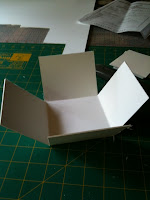The latter is very ambitious. I've wanted to make a chest of this kind since I first saw one at the Adelaide Craft Fair about four years ago. I decided that, because it is expensive and lengthy to make no matter how I do it, I might as well do it in a class and give myself the best chance of success. There were quite a few classes I would have liked to go to, but I took the plunge with Betsy.
Last week the pre-class kit arrived - a chart, threads and linen for the thimble keep component of the project, to be embroidered before the class so the class can focus on construction.
I decided the best way to manage the four different variegated Gloriana threads in such a small space was to keep four needles going.
It proved an exercise in care and patience. Eventually I settled on working with two or three threads, then coming back and filling in the others.
It became easier once I got to the middle section that has a full row of cross-stitch with the same thread forming a base-line for the multi-thread rows either side.
Once I was in the swing of it, it became manageable and enjoyable.
Notwithstanding, I did a fair amount of unpicking to get it right. There are still two errors in the piece which I have, I hope, accommodated so they won't effect the making.

While the look of the back isn't on my priority list, I did pay it some attention in order to manage the threads without tangles.
 It has been a good exercise to orient myself to the class. I have a feel for the threads and this form of counted thread work. When I don't work in this medium all the time I have to get my head right for it.
It has been a good exercise to orient myself to the class. I have a feel for the threads and this form of counted thread work. When I don't work in this medium all the time I have to get my head right for it.As a finishaholic, I am a little daunted by the time it is likely to take me to embroider and construct the whole project, but I'm going to think of it as a series of small pieces and perhaps allow myself some other projects in between .
















































